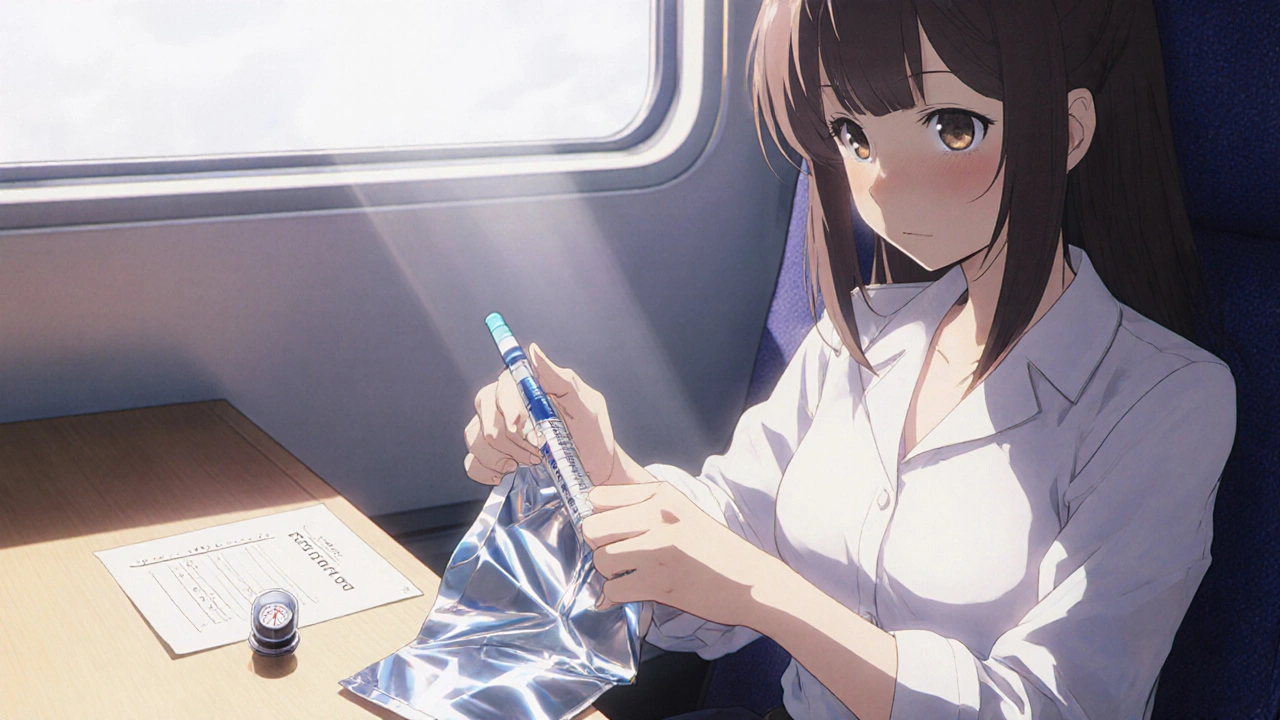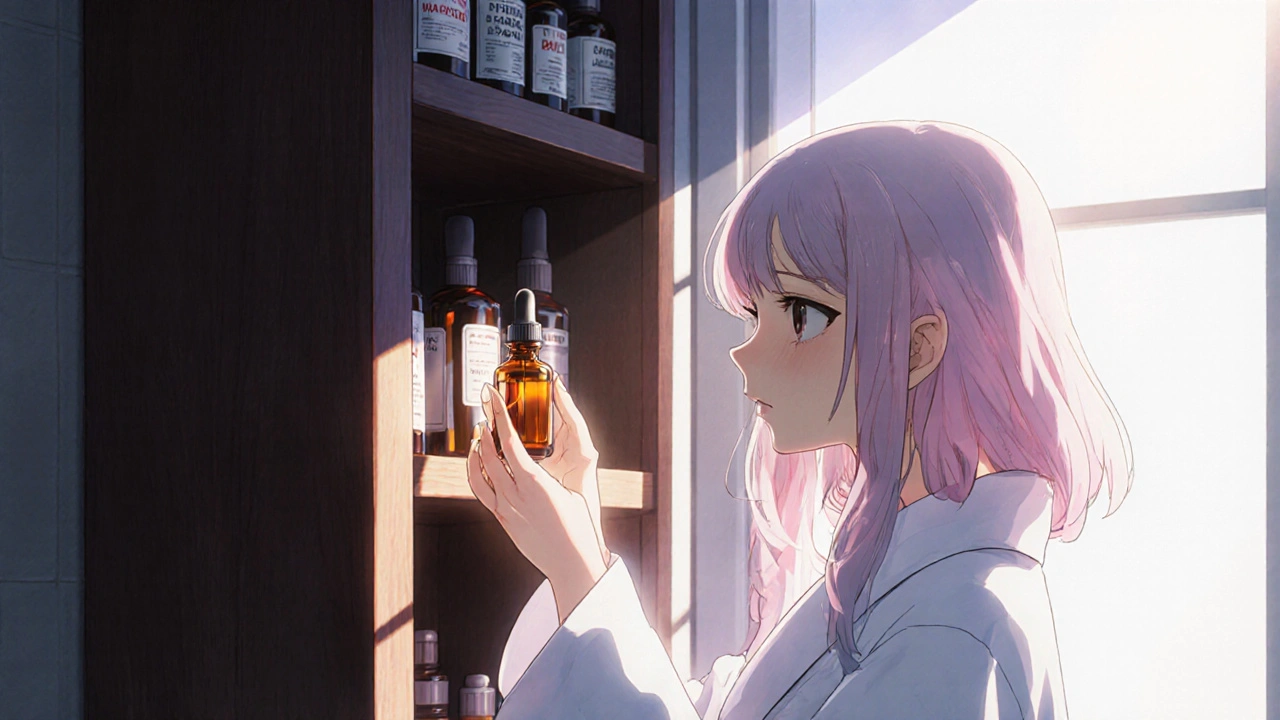When you open a bottle of eye drops or pick up a new prescription, you probably don’t think about the light hitting it. But that sunlight streaming through your bathroom window? It could be quietly ruining your medicine. Light-sensitive medications-like many eye drops, antibiotics, and hormone treatments-can lose half their strength in just a few weeks if exposed to too much light. And it’s not just about effectiveness. Some drugs can break down into harmful compounds. This isn’t theoretical. It’s happening in kitchens, bathrooms, and medicine cabinets across the country.
What Makes a Medication Light-Sensitive?
Not all medications care about light. But if your prescription is an eye drop, a chemotherapy drug, tetracycline, nitroglycerin, or even certain vitamin D or insulin formulations, it’s likely sensitive. These drugs contain chemicals that react when hit by UV or even bright indoor light. The result? A chemical change that makes them weaker-or worse, toxic.
The U.S. Pharmacopeia (USP) lists over 470 injectable medications that need protection from light. Eye drops are especially vulnerable because they’re liquid, stored in small containers, and often kept on counters or bedside tables. A 2021 study from Alcon showed that eye drops stored in clear bottles lost 35% of their potency in just 14 days. That’s not a small drop-it’s the difference between controlling your glaucoma and risking vision loss.
Manufacturers know this. That’s why most light-sensitive meds come in amber, brown, or opaque bottles. These aren’t just for show. Amber glass blocks 98% of harmful UV wavelengths below 470 nanometers. High-quality opaque plastic blocks about 85%. That difference matters. If your medicine came in a clear bottle, it’s either not light-sensitive-or it was improperly packaged. Either way, you need to act.
Where to Store Your Medications (And Where Not To)
The worst place to keep any medication? The bathroom. Heat, humidity, and sunlight make it a perfect storm for degradation. A 2022 survey by the National Community Pharmacists Association found that 68% of people store meds in the bathroom. And 42% of them reported seeing changes-color shifts, cloudy liquids, odd smells.
Instead, pick a cool, dry spot away from windows. A kitchen cabinet above the fridge or in a pantry works well. Avoid placing meds near the stove, dishwasher, or sink. Temperature matters too. Most oral meds are fine between 59°F and 77°F (15°C-25°C). But eye drops? After opening, they should stay between 40°F and 77°F (4°C-25°C). Some, like insulin or biologics, need refrigeration-always check the label.
Here’s a simple rule: if you wouldn’t leave chocolate in that spot, don’t leave your medicine there either. Heat and light both melt effectiveness.
Amber Bottles vs. Opaque Containers: What’s Best?
If your medicine came in an amber bottle, leave it there. Don’t transfer it to a clear pill organizer. That’s one of the most common mistakes. Even if the organizer looks neat, it offers zero protection.
Amber glass is the gold standard. It blocks nearly all UV light and lasts the entire shelf life of the drug. But it’s not perfect. You can’t see how much is left. Some people panic when they can’t tell if they have one drop or ten.
Opaque plastic containers are cheaper and easier to handle. They block 85% of light-good, but not great. They’re also lighter, which helps if you’re traveling. But they don’t last as long under repeated temperature changes.
For travel, consider a UV-blocking medication bag. These insulated pouches, often lined with reflective material, keep meds cool and dark for 8-12 hours. They’re especially useful for insulin, eye drops, or anything refrigerated. Prices range from $20 to $60. Worth it if you fly or commute in summer heat.
Aluminum foil? It blocks 100% of light. But you have to unwrap your medicine every time you use it. That’s a hassle-and people skip it. One study found 32% of patients stopped using foil-wrapped meds because it was too inconvenient.

What Happens When Medication Degrades?
You won’t always know. But here are the signs:
- Eye drops turning cloudy or discolored (yellow, brown, or pink)
- Creams or ointments changing texture-grainy, oily, or separated
- Tablets cracking, chipping, or smelling odd (aspirin smells like vinegar when broken down)
- Medications not working like they used to-your eye pressure isn’t dropping, your rash isn’t fading
If you see any of these, stop using it. Don’t guess. Call your pharmacist. The FDA’s MedWatch program recorded over 300 adverse events in 2022 directly tied to light exposure. That’s not rare. It’s preventable.
Special Rules for Eye Drops
Eye drops are a whole different ballgame. They’re sterile. They’re used near your eyes. And they’re often kept open for weeks. That’s why the American Academy of Ophthalmology says: never transfer eye drops to another container.
Even if the new bottle looks clean, it’s not sterile. And if it’s clear? You’re exposing your eyes to degraded medication. One study found that 18% of eye treatment failures were caused by patients moving drops into clear bottles.
After opening, most eye drops last 4-6 weeks. Check the label. If it says “discard after 28 days,” do it. Don’t stretch it. Even if it looks fine. Bacteria can grow in the dropper tip. Light degrades the active ingredient. Two risks, one bottle.
Some newer multi-dose eye drops come with special UV-blocking coatings inside the bottle. Brands like Bausch + Lomb have designs that extend shelf life by 25%. Ask your pharmacist if yours is one of them.
Traveling with Light-Sensitive Meds
Summer road trips, flights, vacations-these are when meds get messed up. Don’t leave them in the car. Even on a 65°F day, a car parked in the sun can hit 120°F. That’s way past the 86°F safety limit.
Here’s what works:
- Keep meds in your carry-on, not checked luggage.
- Use a UV-blocking insulated bag.
- If refrigerated, pack with a small ice pack (but don’t let it freeze).
- For eye drops, carry the original amber bottle. Don’t use a travel-sized transfer bottle unless it’s labeled UV-protective.
Some smart containers are now in testing-ones with built-in UV sensors that alert your phone if the medicine got too much light. They’re not widely available yet, but watch for them. This is the future.

What to Do If You’ve Already Exposed Your Meds
Accidents happen. You left your eye drops on the windowsill. You forgot your insulin in the car. What now?
Look for signs of damage: color, smell, texture. If it looks normal and you’re unsure, call your pharmacist. They can check the drug’s photostability data. If it’s been exposed for more than a few hours in direct sun, or days in bright light, it’s safer to replace it.
Don’t risk it. A degraded antibiotic won’t kill your infection. A weak glaucoma drop won’t stop your vision loss. The cost of a new bottle is far less than the cost of a hospital visit.
How to Make This Routine
Storing meds right isn’t complicated. It’s just easy to forget. Here’s how to make it stick:
- Check every new prescription for “protect from light” on the label.
- Keep all light-sensitive meds in one cabinet-away from heat and windows.
- Use a small hygrometer to track humidity (aim for below 60%).
- Write the discard date on the bottle when you open it.
- Teach everyone in your household where meds are stored-and why.
Most people get it right after two tries. Once you see the difference in how your meds work, you’ll never forget.
Final Thought: Your Medicine Deserves Better
You wouldn’t leave a bottle of wine in the sun. You wouldn’t leave your phone on a hot dashboard. Why treat your medicine any differently?
Light-sensitive drugs are precise tools. They’re designed to work under controlled conditions. When you ignore those conditions, you’re not saving money-you’re risking your health.
Keep them dark. Keep them cool. Keep them in their original bottles. It’s simple. It’s safe. And it works.
Can I store eye drops in the refrigerator?
Yes, many eye drops can be stored in the fridge after opening-between 40°F and 77°F (4°C-25°C). Refrigeration can help reduce irritation and slow bacterial growth. But check the label. Some eye drops say not to refrigerate. If you do refrigerate them, let them sit at room temperature for 10-15 minutes before use to avoid discomfort. Never freeze them.
What if my medicine came in a clear bottle?
If the label says "protect from light" and it’s in a clear bottle, contact your pharmacy immediately. This is a packaging error. You should be given a proper amber or opaque container. If the label doesn’t mention light protection, it’s likely safe in a clear bottle. But if you’re unsure, ask your pharmacist. Better safe than sorry.
Are all eye drops light-sensitive?
No, not all. But many are-especially those used for glaucoma, infections, or inflammation. Common examples include latanoprost, bimatoprost, ciprofloxacin, and dexamethasone. If the bottle is amber or the label says "protect from light," treat it as sensitive. When in doubt, assume it is.
How do I know if my medication has gone bad?
Look for changes: discoloration (yellow, brown, pink), cloudiness in liquids, separation in creams, unusual smells (like vinegar for aspirin), or tablets that are cracked or crumbling. If you notice any of these, stop using it. Even if it looks fine, if it’s been exposed to light or heat for too long, it may not work as intended.
Can I use a pill organizer for light-sensitive meds?
Only if the organizer is specifically designed to block light. Most clear or plastic pill organizers offer zero protection. If you need to use one, keep the original amber bottle and only transfer pills you’ll take that day. Never store light-sensitive meds long-term in a regular organizer.


Jennifer Bedrosian
OMG I left my glaucoma drops on the bathroom counter for weeks and now I’m scared to even blink 😭 I thought they were fine because they still looked clear. This post just saved my vision. Thank you.